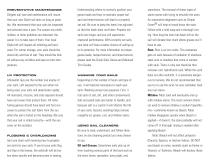
Catalog excerpts

SAIL FABRIC GLOSSARY ASPECT RATIO The luff length of the sail divided by the foot length. BIAS The direction diagonally across a piece of fabric at 45 degrees to the warp and fill. COUNT The number of fibers per inch in the warp or fill. CREEP Permanent, continuous elongation of a fiber under a sustained load. CRIMP The "waviness" of the fiber or yarn when it is laid over and under fibers or yarns in a fabric. Crimp can contribute to the elongation of a fabric under load as it is "pulled out" of the loaded direction and "pushed into" the less heavily loaded direction. CROSS-CUT A sail panel layout in which the seams run roughly parallel to one another, typically perpendicular to the leech. DENIER A measure of the weight of a continuous fiber filament. It is the weight in grams of 9,000 meters of a given fiber. The lower the number, the finer the fiber. Higher denier, heavier fibers are generally more rugged and durable. DENIER PER INCH (DPI) A measure of the fabric's relative weight and strength, expressed as the number of fibers per inch, generally in the primary yarn direction. ELONGATION The difference between the initial length of a fabric sample and its length after stretching, expressed in 1/100ths of an inch. FIBER The basic entity that is twisted into yarns and then used in the production of a fabric. FILAMENT A single fibril of natural or synthetic textile fiber. Filaments are twisted or bunched to form fibers. FILL (WEFT) The yarns or fibers that run across the width of the roll of fabric, perpendicular to the warp direction. FILM An extruded sheet of plastic, most often Mylar® polyester film. Film's desirable properties include low stretch, good bias stability, low porosity and good adhesion. Less desirable properties include low tear strength and relatively high physical shrinkage (due to creases and folds in the film). FLEX STRENGTH The ability of a fiber to retain its strength after being folded back and forth, commonly expressed as percent loss in breaking strength after flutter or fold testing. GSM Weight expressed in grams per square meter. HAND A subjective term for the way the fabric feels when touched. Terms like softness, crispness, dryness and silkiness all describe the hand of the fabric. INITIAL MODULUS/MODULUS A measure of a material's ability to resist stretch. Initial modulus is usually expressed as grams of load per unit stretch for a certain fiber denier. The higher the initial modulus, the less the fiber will stretch. INSERT A yarn or fiber laid directly into a fabric without first being woven or put into a scrim. LAMINATE Fabric constructed from layers of film, scrim and/or taffeta glued together under high pressure and/or heat to form a composite sail material. Sail Care & Maintenance PRIMARY YARN DIRECTION The direction that is most resistant to stretch, typically due to a higher yarn count or a higher modulus fiber. RADIAL A panel layout where the seams and panels radiate from the corners of the sail in the direction of the highest load. SAILMAKERS WEIGHT (SM-oz) Weight in ounces of a piece of fabric measuring 28.5" x 36". SCRIM A base fabric component created by laying out fibers in a grid pattern with the fibers joined at their intersection. A scrim can be constructed by passing fill and warp yarns over and under one another; by knitting, in which the fibers and "tied" at each intersection; or by laying the fibers straight across Your guide to extending the life and performance of your new sail through regular inspection, one another and connecting them at the intersections with glue. TAFFETA An unfinished fabric employed as a covering, usually in laminate sailcloth, often enhancing washing, proper use of sail durability and chafe resistance TENACITY The tensile stress at rupture of a fiber expressed in grams of force per denier. Tenacity cleaners, and protection from relates to the breaking strength of fibers and should not be confused with modulus, which relates more directly with a fiber's ability to resist stretch. TENSILE STRENGTH A measure of the ability of a fiber, yarn or fabric to withstand pulling stresses. ultraviolet rays, overloading, THREADLINE The direction of the fibers or yarns in the warp, fill or bias. UV RESISTANCE A measure of the effect of sunlight on cloth. UV resistance is usually expressed as the time it would take for a material exposed to sunlight to lose half of its breaking strength. WARP The yarns or fibers in a fabric that run the length of a roll of cloth and, in a woven fabric, are interlaced with the fill (weft) yarns. WOVEN Material made by interlacing fibers over and under each other in a regular pattern. Types of weaves include plain, leno and basket, among others. YARN A continuous strand of fibers created when a cluster of individual fibers are twisted together. Yarns are used to create fabrics. www.doylesails.com BETTER
Open the catalog to page 1
PREVENTATIVE MAINTENANCE Diligent sail care and maintenance will insure that your new Doyle sail lasts as long as possible. We recommend that your sails be inspected and serviced once a year. The sooner any chafe, mildew, or other problems are detected, the easier it is to take care of them. Your local Doyle loft will inspect all stitching and hardware. For winter storage, your sails should be stored dry and free of salt. They should be folded without any wrinkles and kept at room temperature. UV PROTECTION Ultraviolet rays are the number one enemy of your sails. Left exposed to the sun...
Open the catalog to page 2All Doyle catalogs and brochures
-
StackPack
2 Pages
-
Anomaly Headboard Brochure
1 Pages
-
Doyle Gear
2 Pages
-
DoyleSailCare
2 Pages
-
doylegear
2 Pages
Archived catalogs
-
Anomaly Headboard Brochure
1 Pages
-
Doyle
1 Pages








